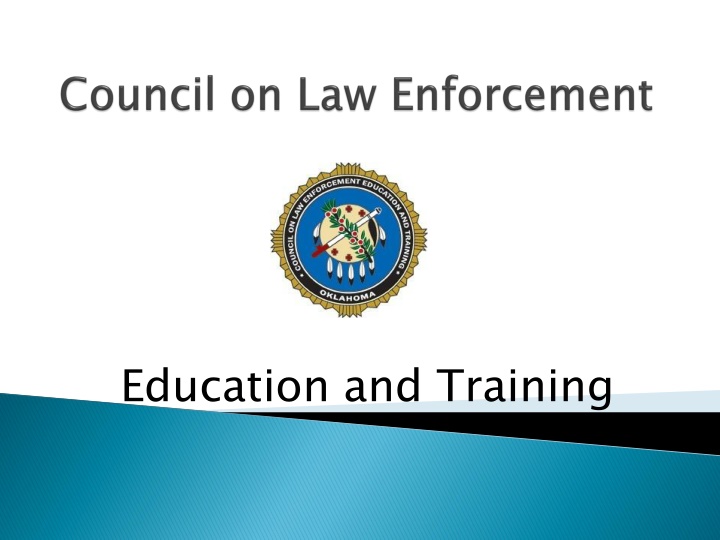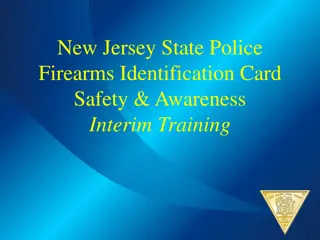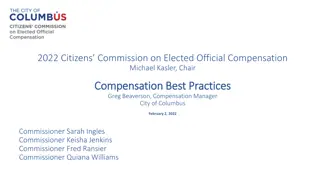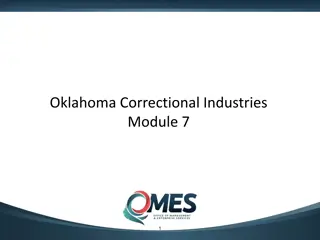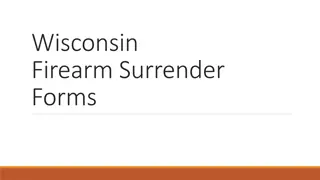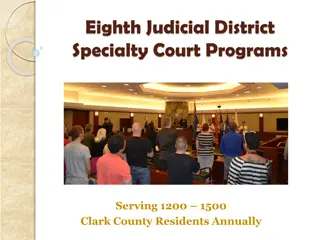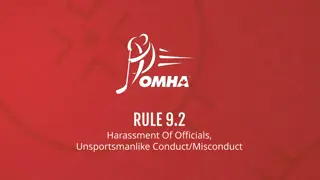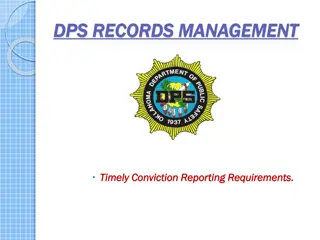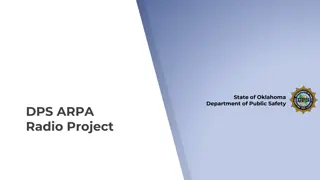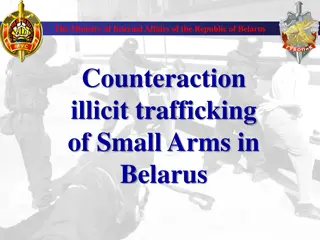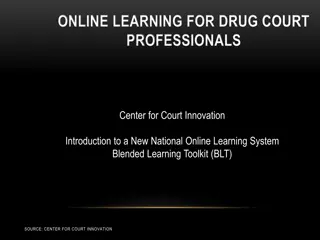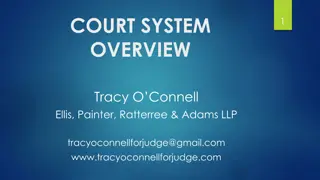Firearms Training for Court Officials in Oklahoma
Court officials in Oklahoma, including District Attorneys, Judges, and U.S. Attorneys, are allowed to carry concealed firearms for personal protection after completing a CLEET-approved handgun qualification course. This course is mandatory prior to carrying a firearm, as per Oklahoma Statutes. Upon successful completion, officials receive a certification card. The process involves classroom instruction, training reports, and form submissions to CLEET.
Download Presentation

Please find below an Image/Link to download the presentation.
The content on the website is provided AS IS for your information and personal use only. It may not be sold, licensed, or shared on other websites without obtaining consent from the author.If you encounter any issues during the download, it is possible that the publisher has removed the file from their server.
You are allowed to download the files provided on this website for personal or commercial use, subject to the condition that they are used lawfully. All files are the property of their respective owners.
The content on the website is provided AS IS for your information and personal use only. It may not be sold, licensed, or shared on other websites without obtaining consent from the author.
E N D
Presentation Transcript
Title 19 O.S. 215.29, Title 20 O.S. 129, Title 21 O.S. 1289.29 and Title 70 3311.14, allow District Attorneys, qualified retired District Attorneys, Assistant District Attorneys, District Judges, qualified Retired District Judges, Municipal Judges, U. S. Attorneys, Assistant U. S. Attorneys, the State of Oklahoma Attorney General, and Assistant Attorneys General to carry a concealed firearm for the purpose of personal protection. Provided first, that they have completed a CLEET approved handgun qualification course.
The handgun qualification course for court officials must be prior to carrying a firearm pursuant to the applicable portion Oklahoma Statutes. To aid in the administration of the course, this power point should be downloaded and utilized during the classroom instruction, if provided.
Once the handgun qualification is successfully completed, and a completed report of training is received, CLEET will mail the participating District Attorneys, qualified retired District Attorneys, Assistant District Attorneys, District Judges, qualified Retired District Judges, Municipal Judges, U. S. Attorneys, Assistant U. S. Attorneys, the State of Oklahoma Attorney General and Assistant Attorneys General a certification card. The following slides show the forms required, and the language on the certification card.
There is a form available on the CLEET website to report the course completion of the participating District Attorneys, qualified retired District Attorneys, Assistant District Attorneys, District Judges, qualified Retired District Judges, Municipal Judges, U. S. Attorneys, Assistant U. S. Attorneys, the State of Oklahoma Attorney General, and Assistant Attorneys General. This form needs to be filled out completely and returned to CLEET.
Firearms Qualification Certificate for District Attorney JOHN DOE This is to certify that CLEET has on file documentation that the named person is a District Attorney for the State of Oklahoma and has successfully completed an approved handgun qualification course conducted by a certified firearms instructor. The named person is in compliance with, and authorized to carry a firearm for personal protection pursuant to 19 O.S. 215.29 as of the date of issuance of this card. _________________________________ _______________ Executive Director, CLEET Firearms Qualification Certificate for District Attorney JOHN DOE Date Issued
Firearms Qualification Certificate for Retired District Attorney JOHN DOE This is to certify that CLEET has on file documentation that the named person is a Retired District Attorney for the State of Oklahoma and has successfully completed an approved handgun qualification course conducted by a certified firearms instructor. The named person is in compliance with, and authorized to carry a firearm for personal protection pursuant to 19 O.S. 215.29 as of the date of issuance of this card. _________________________________ _______________ Steve Emmons, Executive Director, CLEET Firearms Qualification Certificate for Retired District Attorney JOHN DOE Date Issued
Firearms Qualification Certificate for Assistant District Attorney JOHN DOE This is to certify that CLEET has on file documentation that the named person is an Assistant District Attorney for the State of Oklahoma and authorized by the District Attorney to carry a firearm, and has successfully completed an approved handgun qualification course conducted by a certified firearms instructor. The named person is in compliance with, and authorized to carry a firearm for personal protection pursuant to 19 O.S. 215.29 as of the date of issuance of this card. _________________________________ _______________ Executive Director, CLEET Firearms Qualification Certificate for Assistant District Attorney JOHN DOE Date Issued
Firearms Qualification Certificate for District Judge JOHN DOE This is to certify that CLEET has on file documentation that the named person is a District Judge in the State of Oklahoma, and has successfully completed an approved handgun qualification course conducted by a certified firearms instructor. The named person is in compliance with, and authorized to carry a firearm for personal protection pursuant to 20 O.S. 129 as of the date of issuance of this card. _________________________________ _______________ Executive Director, CLEET Firearms Qualification Certificate for District Judge JOHN DOE Date Issued
Firearms Qualification Certificate for Retired District Judge JOHN DOE This is to certify that CLEET has on file documentation that the named person is a Retired District Judge in the State of Oklahoma, and has successfully completed an approved handgun qualification course conducted by a certified firearms instructor. The named person is in compliance with, and authorized to carry a firearm for personal protection pursuant to 20 O.S. 129 as of the date of issuance of this card. _________________________________ _______________ Executive Director, CLEET Firearms Qualification Certificate for Retired District Judge JOHN DOE Date Issued
Firearms Qualification Certificate for Municipal Judge JOHN DOE This is to certify that CLEET has on file documentation that the named person is a Municipal Judge in the State of Oklahoma, and has successfully completed an approved handgun qualification course conducted by a certified firearms instructor. The named person is in compliance with, and authorized to carry a firearm for personal protection pursuant to 20 O.S. 129 as of the date of issuance of this card. _________________________________ _______________ Executive Director, CLEET Firearms Qualification Certificate for Municipal Judge JOHN DOE Date Issued
Firearms Qualification Certificate for U. S. Attorney JOHN DOE This is to certify that CLEET has on file documentation that the named person is a U. S. Attorney, and has successfully completed an approved handgun qualification course conducted by a certified firearms instructor. The named person is in compliance with, and authorized to carry a firearm for personal protection pursuant to 21 O.S. 1289.29 as of the date of issuance of this card. _________________________________ _______________ Steve Emmons, Executive Director, CLEET Firearms Qualification Certificate for U. S. Attorney JOHN DOE Date Issued
Firearms Qualification Certificate for Assistant U. S. Attorney JOHN DOE This is to certify that CLEET has on file documentation that the named person is an Assistant U. S. Attorney, and has successfully completed an approved handgun qualification course conducted by a certified firearms instructor. The named person is in compliance with, and authorized to carry a firearm for personal protection pursuant to 21 O.S. 1289.29 as of the date of issuance of this card. _________________________________ _______________ Executive Director, CLEET Firearms Qualification Certificate for Assistant U. S. Attorney JOHN DOE Date Issued
Firearms Qualification Certificate for Attorney General JOHN DOE This is to certify that CLEET has on file documentation that the named person is the Attorney General for the State of Oklahoma, and has successfully completed an approved handgun qualification course conducted by a certified firearms instructor. The named person is in compliance with, and authorized to carry a firearm for personal protection pursuant to 70 O.S. 3311.14 as of the date of issuance of this card. _________________________________ _______________ Executive Director, CLEET Firearms Qualification Certificate for Attorney General JOHN DOE Date Issued
Firearms Qualification Certificate for Assistant Attorney General JOHN DOE This is to certify that CLEET has on file documentation that the named person is an Assistant Attorney General for the State of Oklahoma, and has successfully completed an approved handgun qualification course conducted by a certified firearms instructor. The named person is in compliance with, and authorized to carry a firearm for personal protection pursuant to 70 O.S. 3311.14 as of the date of issuance of this card. _________________________________ _______________ Executive Director, CLEET Firearms Qualification Certificate for Assistant Attorney General JOHN DOE Date Issued
The required Qualification Report may be downloaded from the CLEET web site at www.ok.gov/cleet. After the qualification has been completed, it should be sent to CLEET at the following address: Council on Law Enforcement Education and Training 2401 Egypt Rd. Ada, Oklahoma 74820
Firearms Training Course Firearms Safety
There are three (3) areas of Firearms Safety 1. General Safety Rules 2. Range Safety Rules 3. Home Safety
General Safety Rules or Universal Safety Rules (USR) USR 1 Treat all firearms as though they are loaded.
General Safety Rules (USR) USR 2 Never point a firearm at anyone unless you are ready and willing to kill that person.
General Safety Rules (USR) USR 3 Keep your finger (primary safety) off the trigger until your sights are ON THE TARGET. ON THE TARGET.
General Safety Rules (USR) USR 4 Always make positive target identification area behind your target. positive target identification, and be sure of the
Range Rules Firearms safety on the range begins with the following four (4) basic premises:
1. The shooter is in sound physical and mental condition. 2. The firearm is of sound design, and has been well-maintained.
3. The ammunition is both safe and fresh. 4. The shooter s holster is properly designed and constructed to fit that shooter s handgun.
Range Rules 1. When you first pick up a firearm, insure it is unloaded. Never lay a firearm down without first unloading it. Instructor: demonstrate the 4 steps of unloading a revolver and a semi-automatic pistol.
Range Rules 2. All firearms brought to the range must be unloaded. (ammunition must be removed from magazines/speedloaders prior to entering the range)
Range Rules 3. Firearms will be loaded on the range only after position has been taken on the firing line, and only after the command to load has been given.
Range Rules 4. No firearm will be taken out of the holster other than when on the firing line, or in a designated dry-fire area.
Range Rules 5. All firearms will be checked for cylinder, chamber, and barrel obstructions before firing. Instructor will demonstrate the proper procedure for this rule.
Range Rules 6. Never until the firearm is clear of the holster and safely pointed down range. Never place your finger on the trigger Safely = target identified, sights on the target, a conscious decision to shoot has been made, and the shooter is sure of their backstop. Safely = target identified, sights on the target, a conscious decision to shoot has been made, and the shooter is sure of their backstop.
Range Rules 7. In the event of a malfunction the shooter will keep their muzzle down range and raise their off-gun hand. Keep the firearm down range until a line officer assists you. The instructor will describe the three most common cartridge malfunctions. (misfire, squib load, and hang-fire)
Range Rules 8. The shooter should not proceed from the firing line to the target area until all firearms are unloaded and holstered, the line has been cleared, and you are instructed to do so by the tower operator or instructor.
Range Rules 9. If you are spoken to while on the firing line, listen, but do not turn around.
Range Rules 10. When transferring a revolver, or a semi-automatic pistol the action should be open, the muzzle toward the ground and it should be presented to the recipient grip first. Instructor: demonstrate
Range Rules 11. If a round, magazine or any other item is dropped, leave it on the ground and raise your non-gun hand for assistance. The shooter should keep their muzzle down range while waiting for assistance. DO NOT bend down and pick up the item unassisted.
Range Rules 12. Do not permit the muzzle of a firearm to touch the ground. In the event the shooter looses control of their firearm it is safer to let the firearm fall to the ground rather than attempt catching the firearm mid-air. Once the firearm is on the ground leave it, your off-gun hand, and wait for assistance from the line officer. leave it, raise
Range Rules 13. All shooters will wear eye and ear protection while on the firing line.
Range Rules 14. Participants are not allowed beverages while on the firing line. Smoking, dipping, or chewing is also not permitted while on the firing line.
Range Rules 15. No Alcoholic Beverages; Narcotic Drugs; or drugs that alter perception or judgment are permitted on the range at any time.
Home Safety A loaded firearm left unguarded, poses a physical threat to: You Your family Your visitors
Home Safety To properly store your firearm(s), and reduce potential liability they must be made: Inaccessible Inoperable
Home Safety Inaccessible to unauthorized persons Store firearms in an area where unauthorized person(s) do not have access. (gun cabinet, vault, lock box etc.) Only the gun owner can determine who should have access to their firearm, as they will bear the potential liability if the firearm is misused.
Home Safety Inoperable to unauthorized person(s). There are numerous commercial locks available to secure your firearm. Even without the purchase of a commercial lock it is still possible to make the firearm inoperable by field stripping the firearm and locking the subassemblies in separate locked containers.
Home Safety The safe handling and safeguarding of a firearm is a firearm owner s personal responsibility. Violations of these principles can lead to injuries, or death and the civil liability which will follow.
